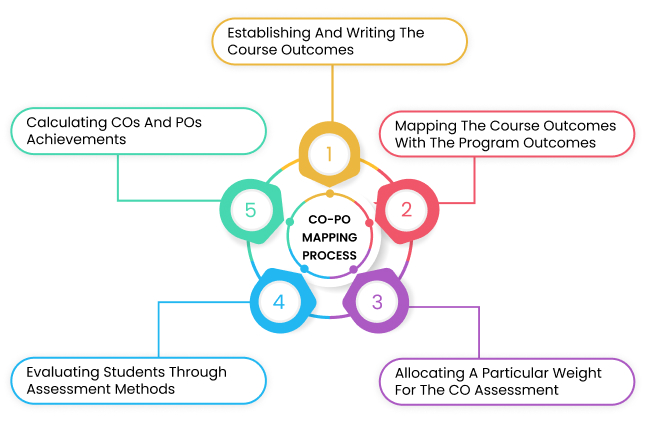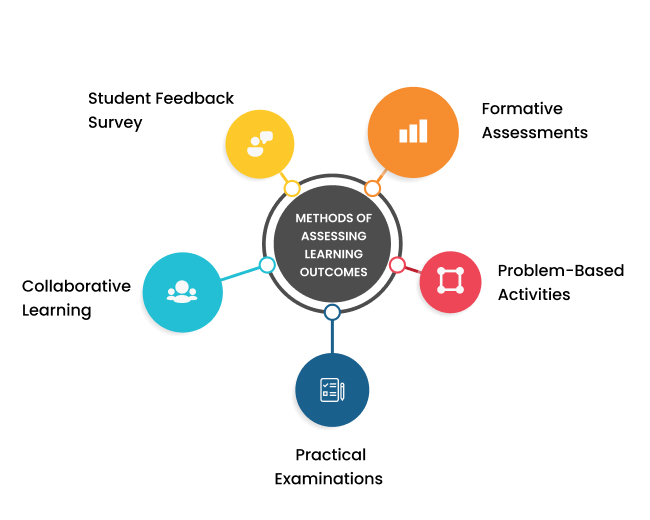CO-PO Mapping: Aligning Outcomes with Learning Activities
Skill, competency, and knowledge are the core components of a modern education system that goes beyond syllabus-centric learning. That is why it is hardly surprising that an outcome-based education approach is essential for preparing well-rounded individuals.
The significance of OBE lies in the teaching, learning, and assessment practices, which allow instructors to develop student's capabilities. Nonetheless, monitoring students’ successes and failures and their ability to adapt to difficulties is pivotal.
Hence, mapping the course outcomes and program outcomes is an integral part of OBE, helping to identify learning and skills gaps.
What are course outcomes and program outcomes?
Course outcomes are among the key components of the OBE framework that define the learning outcomes students accomplish by the end of the course. In fact, COs are broad statements that relate to the knowledge and skills students can demonstrate by the time they complete the course.
Examples of some course outcomes can include: critically analyzing concepts of culture and society with regard to climate change.
Program outcomes are narrower statements that describe the skills and knowledge students should demonstrate by the time they graduate. Hence, teachers and educators ensure that POs align with the Graduate Attributes (GAs).
For instance, evaluate the prevention strategies that have been proposed by the disaster mitigation team. Also, collaborate effectively with the team of professionals and experts to develop appropriate mitigation plans.
However, the first step towards establishing effective course and program outcomes is to write them through a proper framework.
What is the CO-PO mapping process?

Tips for Writing Course Outcomes and Program Outcomes
A course outcome must reflect knowledge and skills as well as the applicability of the particular knowledge and skills that students have acquired. In fact, they must be able to demonstrate the course-specific competencies. Therefore, the course outcomes should include the following aspects:
- Subject content
- Action verbs
- Achievement level
- Modes of performing tasks
Incorporating the SMART (Specific, Measurable, Attainable, Relevant, and Timebound) mechanism while writing course and program outcomes.
- Specific It entails particular behavior and situations.
- Measurable The learning outcome or goal must be measurable by both students and teachers.
- Attainable The objective must be well within the bounds of attainment through effort, application, and planning.
- Relevant The goals and objectives must align with the latest curriculum and educational trends.
- Timebound Educators must stipulate a specific time period within which students must accomplish the outcomes.
On the other hand, attaining program outcomes (POs) depends on the achievement levels of the accompanying COs and the gradual students' strengths. Also, both of them are interrelated and require a framework like Bloom’s taxonomy for effective planning and tracking.
Furthermore, POs must align with graduate attributes and are known as program learning outcomes (PLOs).
Bloom's Taxonomy in Mapping COs and POs
Bloom’s Taxonomy is a hierarchical educational framework that serves to streamline learning objectives into different levels of complexity. Therefore, it provides a systematic order for students to master one learning level and then progress to the next one.
Besides, Anderson and Krathwohl (2001) revised it years after its original publication; hence, educators follow the updated version. Furthermore, it is an excellent source of guidance that enables teachers to write learning objectives.
The taxonomy entails six learning or achievement levels that have been interspersed between three core domains, which are as follows:.
| Cognitive Domain | Affective Domain | Psychomotor Domain |
|---|---|---|
| Knowledge | Receiving | Perception |
| Understanding | Responding | Set |
| Application | Valuing | Guided Response |
| Analysis | Organizing | Mechanism |
| Synthesis | Characterizing | Complex Overt Response |
| Evaluation | Assessing | Adaptation |
The revised taxonomy has two dimensions in the cognitive domain, namely the knowledge dimension and the cognitive dimension. On the other hand, there are four levels in the knowledge dimension, which are factual, conceptual, procedural, and metacognitive.
Using Bloom’s Taxonomy to Map COs and POs
Teachers play an integral role as facilitators, mediators, and mentors who design the course of the academic journey for all students. They can use Bloom’s Taxonomy to write the learning outcomes and monitor the CO-PO progress. Furthermore, the strategic use of action verbs for Bloom’s taxonomy’s three domains is essential.
- Cognitive Domain :
- Affective Domain
- Psychomotor Domain
This domain includes high-order and low-order thinking capabilities that students develop throughout an academic year. Hence, it includes the ability to recall simple facts to draw connections between two specific ideas.
Therefore, teachers can assign activities wherein students can distinguish and differentiate between two board themes.
This domain pays selective attention to stimuli or attributes, value or worth to something. It highlights the feelings, opinions, and emotions that influence learning and behavior.
Some of the activities that teachers can assign may include questions such as: express your views regarding the new changes in the criminal justice system.
The area reflects the learner’s mental, physical, and emotional readiness to respond accordingly. It also relates to their confidence, efficiency, proficiency, and adaptability.
Therefore, activities that allow students to experiment with or demonstrate their skills in real time are central to gauging learning levels in this domain.
Methods of Assessing Learning Outcomes
Mapping COs and POs is instrumental for the OBE process; that is why conducting timely assessments is crucial to tracking the learning outcomes. Furthermore, direct and indirect assessments prove to be great tools, and some of them are as follows:

1. Formative Assessments
Conducting weekly class tests is a type of formative assessment that seeks to assess students’s ongoing development. Therefore, teachers can move beyond the traditional long question-and-answer format.
Impromptu quizzes, multiple-choice questions, and short question-and-answer sessions can be part of class tests. Furthermore, concept maps are equally useful, wherein students arrange ideas into a graphical or visual format. For instance, they can be charts, diagrams, tables, flowcharts, etc.
2. Problem-Based Activities
The foundational structure of outcome-based education lies in learning outcomes and objectives that require timely evaluation. Teachers should strive to evaluate the skills and competencies that students have gained.
That is why assignments that encourage researching real-world problems are crucial, helping students gain active learning experience. Moreover, students use critical thinking and problem-solving skills to solve real-world problems.
For instance, students can prepare business ideas or design a blueprint for a product that can potentially solve a community need.
Additionally, teachers can use the technique to map program outcomes and identify learning and skill gaps.
3. Practical Examinations
Possessing theoretical knowledge without knowing its practical significance is of little or no value. In fact, technical know-how must go in tandem with theory if an individual seeks to succeed in a particular field.
Hence, practical examinations go beyond providing the stipulated marks in exams; they provide an opportunity for students to show their skills. In fact, teachers can assess if students possess the relevant skills to solve complex issues.
4. Collaborative Learning
Do students possess the quality or competencies to present a problem and provide an adequate solution? Addressing such questions is imperative, especially to break away from the outdated mechanism of passive learning.
OBE promotes active learning; therefore, collaborative learning is an excellent medium for students to demonstrate their work. Teachers can ask students to choose a critical topic that they feel has been impacting society, country, or the world.
A group of three or four students can work on a single topic, each of them sharing equal responsibility and contributing effectively. Finally, they can give a presentation on a stipulated date. Consequently, such assignments foster leadership, communication, skills, teamwork, and socio-emotional learning.
5. Student Feedback Survey
Which activities do you enjoy the most in the classroom? If given a choice, what changes would you like to see in the assessment methods? Is there any particular activity that you would like the teacher to conduct in the class?
Teachers can include such questions in the surveys, allowing students to voice their opinions regarding their preferences. Also, the question does not always have to be related to academics; it can include infrastructure, administrative, and related queries.
In effect, teachers can utilize the information or data from the survey to improve classroom or pedagogical practices.
Moreover, teachers must use other assessment techniques: internal assessment, semester-end examination, teacher feedback survey, mock test, mini project, etc.
Final Thoughts,
Outcome-based education is a prominent educational methodology that institutes, particularly engineering colleges, have implemented worldwide. In order to ascertain the steady progress of students, teachers must map course and program outcomes.
The CO-PO mapping process includes establishing appropriate course outcomes, mapping the outcomes, and organizing assessments. The final step includes careful calculation of COs and POs.




